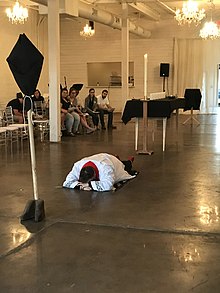
Back ཕྱག་འཚལ། Tibetan Prostration Danish Prostratio German Prosternación Spanish سجده Persian Prosternation French साष्टांग प्रणाम Hindi Sembah sujud ID Prosternazione Italian Prostracija Lithuanian


Prostration is the gesture of placing one's body in a reverentially or submissively prone position. Typically prostration is distinguished from the lesser acts of bowing or kneeling by involving a part of the body above the knee, especially the hands, touching the ground.
Major world religions employ prostration as an act of submissiveness or worship to a supreme being or other worshiped entity (i.e. God), as in the metanoia in Christian prayer used in the Eastern Orthodox and Oriental Orthodox Churches and the sujud of the Islamic prayer, salat.[1] In various cultures and traditions, prostrations are similarly used to show respect to rulers, civil authorities and social elders or superiors, as in the Chinese kowtow or Ancient Greek proskynesis. The act has often traditionally been an important part of religious, civil and traditional rituals and ceremonies, and remains in use in many cultures.
- ^ Dawood, Bishoy (8 December 2013). "Stand, Bow, Prostrate: The Prayerful Body of Coptic Christianity : Clarion Review". Clarion Review. Retrieved 27 July 2020.
© MMXXIII Rich X Search. We shall prevail. All rights reserved. Rich X Search